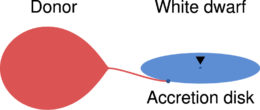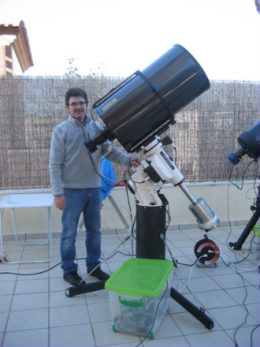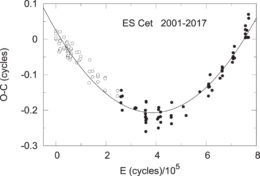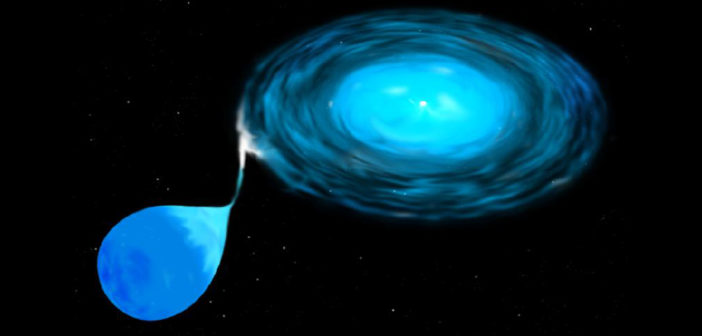What can you do with a team of people armed with backyard telescopes and a decade of patience? Test how binary star systems evolve under Einstein’s general theory of relativity!
Unusual Variables
Cataclysmic variables — irregularly brightening binary stars consisting of an accreting white dwarf and a donor star — are a favorite target among amateur astronomers: they’re detectable even with small telescopes, and there’s a lot we can learn about stellar astrophysics by observing them, if we’re patient.

Diagram of a cataclysmic variable. In an AM CVn, the donor is most likely a white dwarf as well, or a low-mass helium star. [Philip D. Hall]
Why study AM CVn stars? Because their unusual configuration allows us to predict the behavior of their orbital evolution. According to the general theory of relativity, the two components of an AM CVn will spiral closer and closer as the system loses angular momentum to gravitational-wave emission. Eventually they will get so close that the low-mass companion star overflows its Roche lobe, beginning mass transfer to the white dwarf. At this point, the orbital evolution will reverse and the binary orbit will expand, increasing its period.

CBA member Enrique de Miguel, lead author on the study, with his backyard telescope in Huelva, Spain. [Enrique de Miguel]
Backyard Astronomy Hard at Work
Measuring the evolution of an AM CVn’s orbital period is the best way to confirm this model, but this is no simple task! To observe this evolution, we first need a system with a period that can be very precisely measured — best achieved with an eclipsing binary system. Then the system must be observed regularly over a very long period of time.
Though such a feat is challenging, a team of astronomers has done precisely this. The Center for Backyard Astrophysics (CBA) — a group of primarily amateur astronomers located around the world — has collectively observed the AM CVn star system ES Ceti using seven different telescopes over more than a decade. In total, they now have measurements of ES Ceti’s period spanning 2001–2017. Now, in a publication led by Enrique de Miguel (CBA-Huelva and University of Huelva, Spain), the group details the outcomes of their patience.
Testing the Model

This O–C diagram of the timings of minimum light relative to a test ephemeris demonstrates that ES Ceti’s orbital period is steadily increasing over time. [de Miguel et al. 2017]
What’s next for ES Ceti? Systems such as this one will make for interesting targets for the Laser Interferometer Space Antenna (LISA; planned for a 2034 launch). The gravitational radiation emitted by AM CVns like ES Ceti should be strong enough and in the right frequency range to be detected by LISA, providing another test of our models for how these star systems evolve.
Citation
Enrique de Miguel et al 2018 ApJ 852 19. doi:10.3847/1538-4357/aa9ed6


1 Comment
Pingback: backyard astronomer tests General Relativity